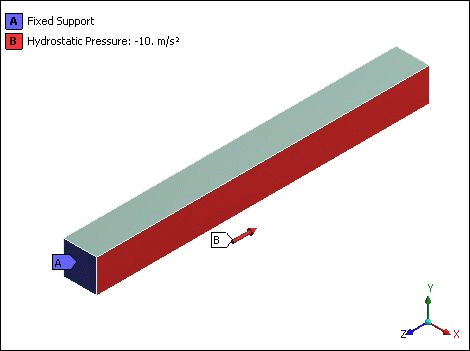VM-WB-MECH-042
VM-WB-MECH-042
Hydrostatic Pressure Applied on a Square Bar Fully and
Partially Submerged in a Fluid
Overview
| Reference: | Any Basic Strength of Materials Book |
| Solver(s): |
Ansys Mechanical |
| Analysis Type(s): | Static Structural Analysis |
| Element Type(s): | Solid |
Test Case
Long bar 20m x 2m x 2m is immersed in a fluid and is fixed at one end. Fluid density is 1000 kg/m3 and Hydrostatic acceleration is 10 m/s2 in negative Z direction. Hydrostatic pressure is applied on a longitudinal face normal to X-axis at different locations as given in the scenarios below. Find normal stress in Z direction of square bar.
Scenario 1: Square bar is partially immersed in the fluid up to 15 m in Z direction from the fixed support.
Scenario 2: Square bar is fully immersed in the fluid up to 25 m in Z direction from the fixed support
| Material Properties | Geometric Properties | Loading | |||||||
|---|---|---|---|---|---|---|---|---|---|
|
|
|
Analysis
Scenario 1: Partially Submerged (Pressure distribution in triangular form)
Pressure distribution on square bar in triangular form, one end is maximum and other end is zero
Pressure on square bar = P = ρ x g x h
Load per meter is w = P x L
Maximum bending moment =
Normal stress = Bending stress = Maximum bending moment / Sectional Modulus
Scenario 2: Fully Submerged (Pressure distribution in trapezoidal form)
Maximum bending moment =
where:
| W1 = Maximum Load per meter (@ 25m) |
| W2 = Minimum Load per meter (@ 5m) |
| Normal stress = Bending stress = Maximum bending moment / Sectional Modulus |



